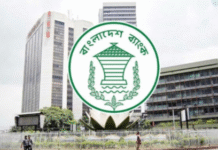
For over a decade, various initiatives have been taken to enhance regional connectivity between Bangladesh, India, Nepal and Bhutan. In addition to increasing people to people communication, new routes have been introduced through river, road, railway and airways for easy freight transport.
Due to its geographical location, Bangladesh is at the centre of building this four-nation regional communication system. Bangladesh is being given priority in almost all routes – bilateral and multilateral.
Bangladesh has already provided transit and transshipment facilities though river routes and roads to the northeastern states of India. Chattogram port has also been opened to India for transportation of its goods. Discussions with India on increasing trade and commerce started after the present government came into power in the first term.
Several routes have been introduced between India and Bangladesh for direct passenger transport such as Khulna-Kolkata railway, Dhaka-Agartala by bus, Dhaka-Guwahati flight, to increase people to people communication. The Dhaka-Siliguri passenger train is scheduled to be launched this month. Discussions on launching freight and passenger transport are also at the final stages. Buses on Dhaka-Siliguri-Gangtok and Dhaka-Kathmandu routes have also been piloted.
Distinguished fellow of non-government research organisation Centre for Policy Dialogue (CPD), Mustafizur Rahman told Prothom Alo that some agreements and infrastructure- elated to the connectivity with India and other neighbouring countries have been developed. These initiatives are positive and should be implemented immediately.
The World Bank (WB) has conducted a study on how much India and Bangladesh could benefit from the increased inter-country connectivity between the two countries. The study of the WB published on 9 March states that the national revenue of Bangladesh will increase by 17 per cent if an uninterrupted transport system could be introduced between India and Bangladesh. This will raise the revenue of India by 8 per cent. The actual income will increase by 67 per cent in Dhaka and 59 per cent in Chattogram. Overall, the actual income of the eastern districts of Bangladesh and some western districts will increase by 25 to 40 per cent. Bangladesh’s exports to India could increase by about 300 per cent if a Free Trade Agreement (FTA) is signed by the two countries and uninterrupted vehicular movement could be ensured.
Maitri bridge is giving hope
The Bangladesh-India Maitri bridge over the Feni river near the border between Ramgarh area of Khagrachhari in Bangladesh and Sabroom of South Tripura in India was inaugurated on 8 March. This bridge is being referred as the “gateway” to the east of South Asia, because it will be easy to transport goods to seven northeastern states of India including Assam and Tripura via Chattogram port.
This railway is now being considered as the lifeline or economic corridor of seven northeastern states including Assam, Tripura, Arunachal and Mizoram. There are roadways too. A direct road connection has been introduced with Sabroom through Ramgarh Maitri Bridge in Khagrachhari. The shipment of goods will reach Sabroom by crossing only 100km of roads from Chattogram port via Sitakunda and Mirsarai.
New waterways are opening up
In the last 10 years, at least four new waterways have been launched between Bangladesh and India. One of these is transit and three are bilateral trade routes. From Kolkata to Ashuganj by water and from Ashuganj to Agartala via Akhaura by road — this route is basically a transit route. Consignments of stone and iron for the construction of railways in Tripura have gone this way.
Last November, transport of transit freight started in another route, from Karimganj in Assam to Ashuganj via Zakiganj in Sylhet by river routes and later by road to Agartala. About 21,000 tonnes goods have so far been transported to India through Ashuganj port. A jetty and warehouse have already been constructed at the Ashuganj port. Work is underway to upgrade the 48 km road from Ashuganj to Akhaura into four lanes with loan from India.
A route from Daudkandi to Sonamura in Sipahijala district of Tripura via Cumilla through the Gomati river and later a road to Agartala was officially launched last August. This has been done to expand bilateral trade. There is a navigability crisis in this route. The Bangladesh Inland Water transport Authority (BIWTA) is now looking into find where the navigability crisis lies. BIWTA will soon start dredging to resolve the navigability crisis. Besides, trade has started between Kurigram and Dhubri in Assam through the Brahmaputra river.
Large boulders are being transported in this route. Last September, BIWTA approved the transportation of goods from Sultanganj in Godagari upazila of Rajshahi to Maya river port in Murshidabad. It is now awaiting clearance from the customs department.
BIWTA director Rafiqul Islam told Prothom Alo that the cost of transporting products by river route is much less. So in the last few years multiple river routes have been launched between India and Bangladesh. If these river routes are fully operational, Bangladesh’s exports to northeast India will increase. Indian traders will be able to import products from Bangladesh by river route in the fastest time at low cost too. He said dredging is already underway on the Zakiganj river route. Various initiatives have been for dredging and to make Gomati and other rivers suitable for movement at night.
Transportation of products increased on river routes
There have has export and import between the two countries under the Trade Agreement Protocol of 1972. Within four years, transportation of goods increased by more than 100,000 tonnes. In the 2016-17 fiscal year, the total import and export by river routes was about 2.6 million (26 lakh and six thousand) tonnes. It increased to 2.7 million (27 lakh and two thousand) tonnes in 2018-19 fiscal year. In the last fiscal year, this was 2.3 million (23 lakh and seven thousand) tonnes. However, due to the pandemic, the river routes were closed for about three months.
Passenger transport from Kolkata to Guwahati in Assam via Khulna-Chandpur-Nagarbari-Sirajganj-Kurigram in Bangladesh started from 2019. Two Indian vessels and one Bangladeshi vessel are transporting passengers. However, passenger transport is not regular.
Chattogram port being used
In November 2018, an agreement was reached in Delhi between the two countries to transport products to the northeastern states of India via the port of Chattogram. In October of the following year, the Standard of Procedure (SOP) was signed on the method of transporting products on this route. In July 2020, India imported a test consignment via Chattogram port for the first time. A consignment of four containers of steel and consumer products came by a ship from Kolkata to Chattogram port and later from Chattogram to Agartala via Cumilla and Akhaura. However, transportation of products via Chattogram port is still to be regularised.
Dhaka-Kolkata-Kathmandu on the same string
In order to increase people to people communications as well as to facilitate the transportation of products, an initiative was taken six to seven years ago to simultaneously increase regional connectivity between Bangladesh, India, Nepal and Bhutan, known as BBIN.
In June 2015, under the auspices of the BBIN, an agreement was signed between the four countries in Bhutan’s capital Thimphu for the free movement of motorised vehicles. But the upper house of Bhutan’s parliament has not yet approved the agreement in fear of environmental damage. For the time being, initiatives have been taken to implement the free movement agreement excluding Bhutan.
A consignment of Vodafone Company’s equipment was transported from Kolkata to Agartala via Akhaura in Bangladesh under a pilot consignment in November, 2015. Nepal and Bhutan have been granted to use their lands to reach Bangladesh. Nepal and Bhutan have been asking for permission to use the Mongla port. This too will be easier now. Apart from that, Bangladesh has already permitted Bhutan to use the Syedpur port.
Regarding this issue, commerce secretary Md Jafar Uddin told Prothom Alo that our business will expand if our inter-connectivity with the neighbouring countries increases. For this, investments should be increased along with infrastructural development. Apart from solving the navigability crisis, facilities at the ports are also being increased. The opportunities for trade assistance are increasing gradually.
*This interview appeared in the print and online editions of Prothom Alo and has been rewritten in English by Ashish Basu










In the write up, everything seems to be for India. What’s in it for Bangladesh? Practically zero. All the percentages are theory. In reality, I doubt if Bangladesh will be benefitted at all. We are just prostituting our sacred motherland.